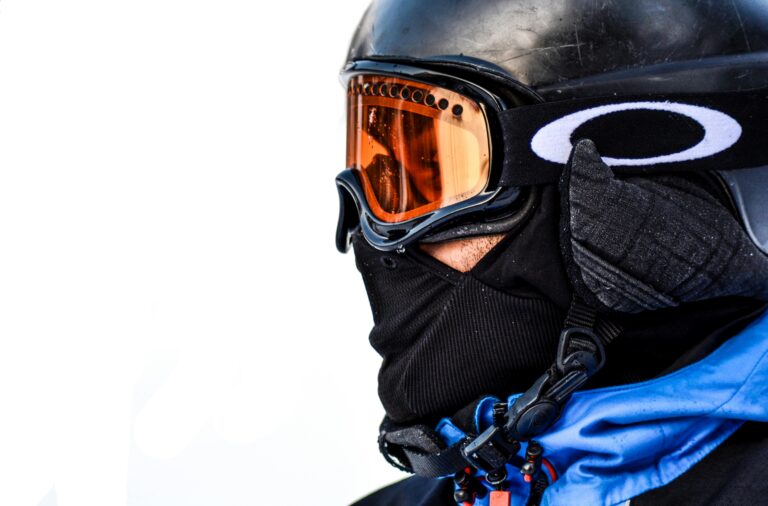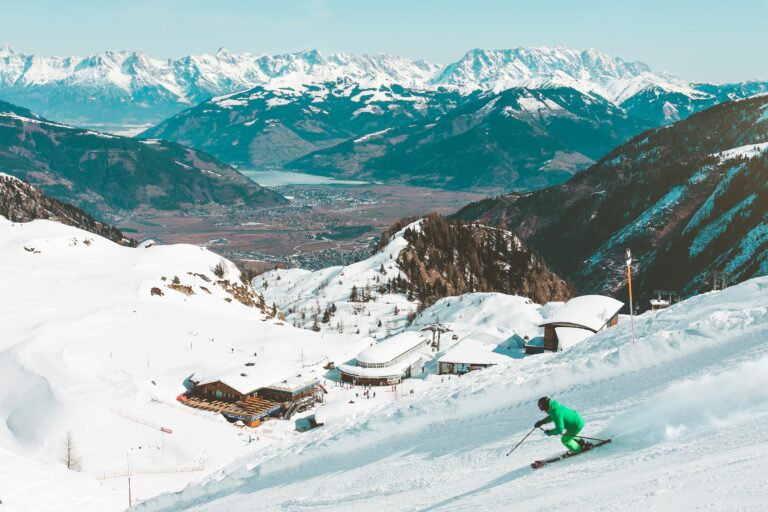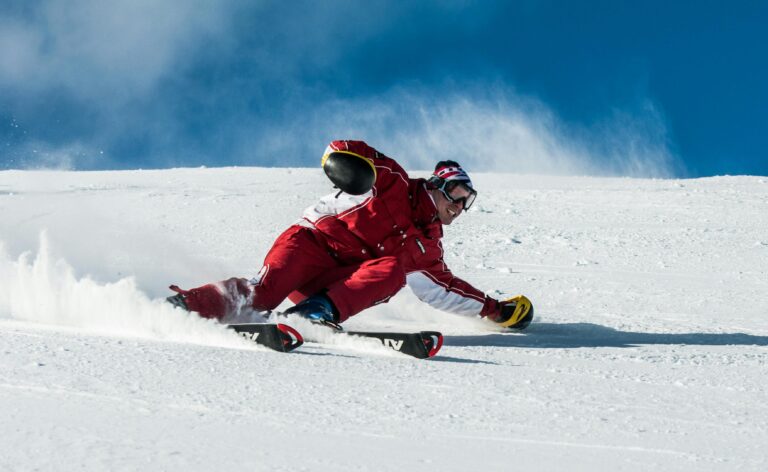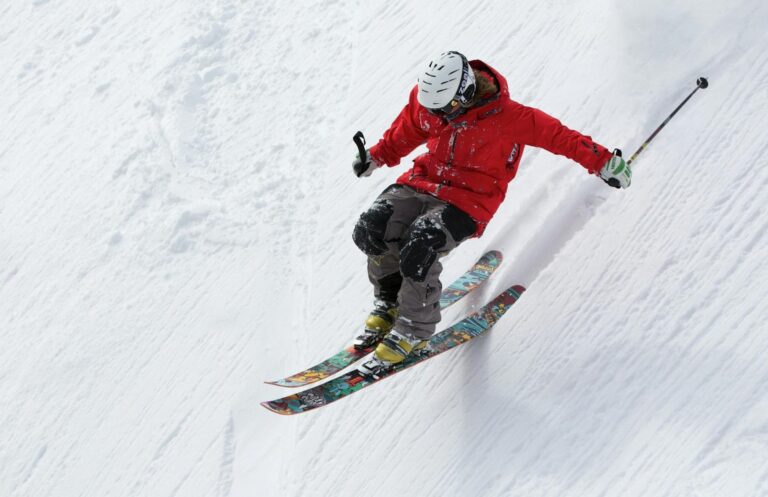Skiing steep slopes is like strapping yourself into a wild roller coaster—you feel that rush of speed and the thrill of the challenge right away. But before you plunge down any intimidating run, you need a solid grip on some key techniques to stay safe and in control. This guide’s for intermediate and advanced skiers eager to own those steep descents. Focus on balance, control, rhythm, and a bit of prep, and you’ll be turning tough terrain into your playground.
Ready to jump in? These steps will keep you steady. And if you want to brush up on skills that also help on moguls, check out our beginner’s guide to skiing moguls. Whether it’s bumps, powder, or icy drops, mastering the basics in these guides transforms your whole experience.
Step 1: Maintain Balance Over Your Downhill Ski

What to Do:
Stay balanced over your downhill ski—yes, really over it. It might feel natural to lean into the slope, but fight the urge.
Why It’s Important:
When your weight is centered right over the downhill ski, you gain control and make smoother turns. Lean back? That’s a recipe for losing your balance fast.
How to Do It:
- Engage your hips to line up over the downhill ski.
- Flex your ankles so your shins press into your boots.
- Keep your upper body just slightly forward to balance your weight.
Common Mistakes and Pro Tips:
- Mistake: Leaning back as soon as the slope pitches.
- Pro Tip: Practice foot pressure drills and use your poles lightly to stabilize.
“The key is to shift your weight forward at the start of the turn and adjust slightly back toward the end to maintain grip.”
— Tom Gellie, Level 4 Instructor, APSI
Step 2: Center Your Weight Over the Middle of Your Skis
What to Do:
Keep your weight evenly spread over the middle of both skis throughout your run.
Why It’s Important:
When balanced in the middle, both ski edges engage properly—especially crucial on steep, icy patches.
How to Do It:
- Bend your knees and lean your waist slightly forward to avoid falling back.
- Engage your core and hold your arms forward in an athletic stance.
Common Mistakes and Pro Tips:
- Mistake: Dropping into a “backseat” stance when things get scary.
- Pro Tip: Pole plants are your friend here—use them as rhythm cues to keep pushing forward.
Step 3: Focus on Rounded Turn Shapes
What to Do:
On steep slopes, aim for smooth, rounded turns. Skip the jerky, choppy moves.
Why It’s Important:
Smooth turns spread forces evenly, so you keep control. Quick or abrupt turns? That’s how skiers get in trouble.
How to Do It:
- Picture your turn like the hands of a clock moving gently from 12 to 6.
- Make sure you complete each turn before starting the next one.
Common Mistakes and Pro Tips:
- Mistake: Rushing turns, which makes your run feel stop-and-go.
- Pro Tip: Keep a steady rhythm, and turn your head toward the next turn early to get your body aligned.
Step 4: Progress Gradually to Steeper Terrain
What to Do:
Don’t rush into black diamond runs. Take your time moving up.
Why It’s Important:
Jumping straight to steep slopes can lead to wipeouts and a confidence crash.
How to Do It:
- Warm up on easier slopes first to feel ready.
- Gradually step up to tougher terrain—no need to jump in headfirst.
Common Mistakes and Pro Tips:
- Mistake: Thinking you’re ready for black runs right after blue runs.
- Pro Tip: Trust your gut. If a slope feels sketchy, back off to something comfortable.
Step 5: Control Your Speed
What to Do:
Keep your speed in check and always finish each turn before starting the next.
Why It’s Important:
If you don’t manage your speed, you risk losing control when things get steep or tricky.
How to Do It:
- Slow down on purpose before turns instead of relying on your turns to brake for you.
- Find a speed that feels safe and lets you react quickly.
Common Mistakes and Pro Tips:
- Mistake: Panicking and rushing turns, which creates chaos.
- Pro Tip: Use a simple mantra like “slow down to turn” to stay calm and focused.
Bonus Tip: Mindset Before the Descent
What to Do:
Just before you hit the steep slope, take a moment to visualize the run.
Why It’s Important:
A clear, positive mindset can boost your confidence and performance.
How to Do It:
- Pick a little mantra like “Shins forward, reach the pole plant.”
- Repeat it in your head to block out distractions before launching down.
Advanced Techniques for Steep Slope Mastery
Once you’ve nailed the basics, these advanced tactics will push your skills and safety further.
Use of Pole Plants for Rhythm and Support
Pole plants on steep slopes help time your turns and keep balance. Plant them slightly earlier than on gentle slopes to create a rhythm that controls speed and syncs your movements.
Dynamic Edging Adjustments
Adjusting your edging pressure on the fly helps hold your grip through mixed conditions. Push edges harder on ice and ease off on soft snow to avoid skidding. It takes practice, so try this on intermediate runs first.
Angulation and Inclination
Balancing your body between angulation (hip bending) and inclination (leaning into the turn) is what keeps you carving tight turns without slipping off edges. More angulation keeps your center over your skis, which is key on steep terrain.
Gear Tips for Steep Slope Skiing
Your gear matters on steep runs. Here’s what works best:
- Ski Selection: Choose skis with moderate to narrow waists and strong torsional stiffness for better edge grip.
- Boot Fit and Flex: Go for snug boots with slightly stiffer flex to transfer power and hold stability.
- Safety Gear: Always wear a helmet. Consider back protectors and avalanche gear if you’re venturing off-piste.
Summary Table of Key Techniques
| Technique | Action Item | Importance |
|---|---|---|
| Maintain Balance | Stay centered over your downhill ski | Ensures control and path flexibility |
| Center Weight | Distribute weight evenly over the middle of your skis | Enhances grip and stability |
| Rounded Turns | Visualize paths from 12 to 6 | Facilitates smoother transitions |
| Gradual Progression | Take on steeper runs in stages | Builds confidence; prevents injury |
| Speed Control | Finish each turn before starting another | Prevents loss of control |
| Set Mindset | Use a phrase to keep focus before skiing | Optimizes preparedness for the descent |
| Use Pole Plants Effectively | Plant poles early to set rhythm | Helps maintain balance and initiate turns |
| Edging Adjustment | Adapt edging pressure to snow conditions | Improves grip and controls speed |
| Angulation vs Inclination | Lean into turns using angulation to keep balance | Maintains edge grip and turn precision |
FAQs
What are common fears when skiing on steep slopes?
Fear usually comes from feeling out of control or worried you’ll fall. That’s totally normal. Most of us get anxious when trying new terrain. Breaking everything down—like balance and edging—and practicing progressively helps you beat those jitters. Skiing with a friend or instructor can be a big confidence boost.
How can I know I’m ready for steeper runs?
If you can handle controlled turns on intermediate slopes without losing speed or balance, you’re probably ready. You should feel solid in your stance, able to adjust to changing snow. If you keep getting off balance or can’t finish turns smoothly, spend more time on easier runs first.
What is fore/aft balance, and why is it crucial?
Fore/aft balance is how your weight sits between the front and back of your skis. On steep slopes, it controls how well your edges bite and how responsive your skis feel. Too far back, and you’ll skid out. Too far forward, and you’ll get tired faster and can’t react well. The right balance keeps your skis carving and your body ready to adjust.
How do I effectively control my speed while skiing steep?
Controlling speed means managing momentum, not just slowing down. Finish each turn to help scrub speed. Use long, smooth turns and timely pole plants to keep steady. If you need to slow more, side slip or traverse instead of stopping suddenly. Try saying “slow down to turn” to keep calm.
What should I do if I feel scared mid-run on a steep slope?
First, don’t panic. Slow your speed by making wider turns or side slipping. Focus on your breathing and the techniques you’ve practiced. If you’re still overwhelmed, safely stop to catch your breath and reset. It’s okay to choose an easier path—confidence grows with every run.
Can lessons improve my steep slope skiing skills?
Definitely. A good instructor spots what you miss, helps fix your form, and gives you drills that fit your skill. They also help handle the mental hurdles. Private or group lessons focused on steep terrain can speed up your progress and keep you safer.
When you practice these tips, you’ll feel your confidence rise, and those steep slopes will become less daunting and more a chance to show off your skills. Remember, skiing steep is all about balancing risk with control.
So go ahead—embrace the challenge, push your limits, and above all, ski safe and smart. Happy carving!
Additional Resource Links:
For more tips, check out:





